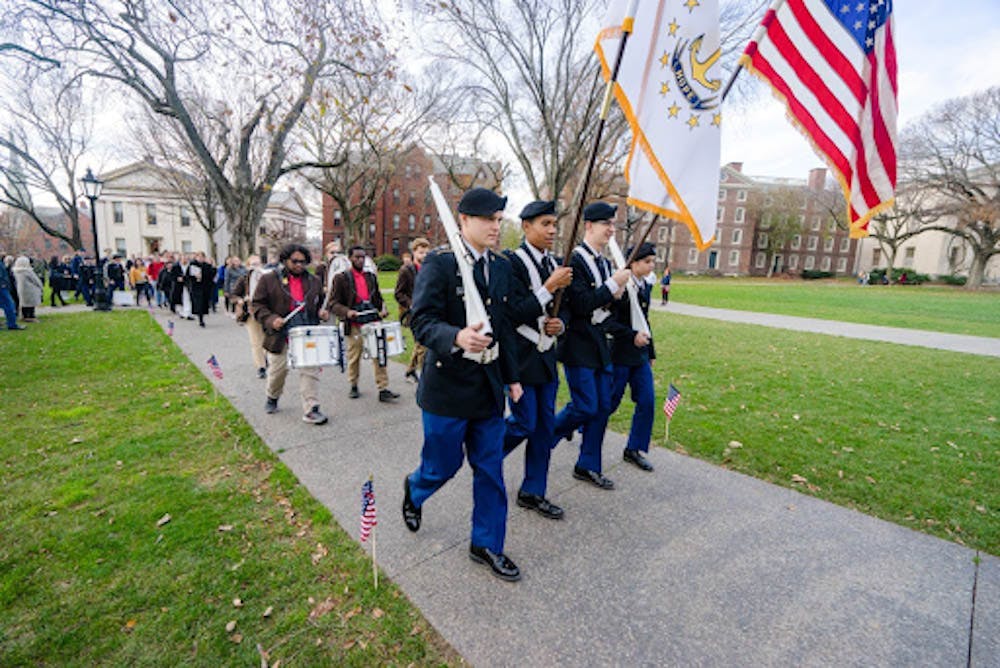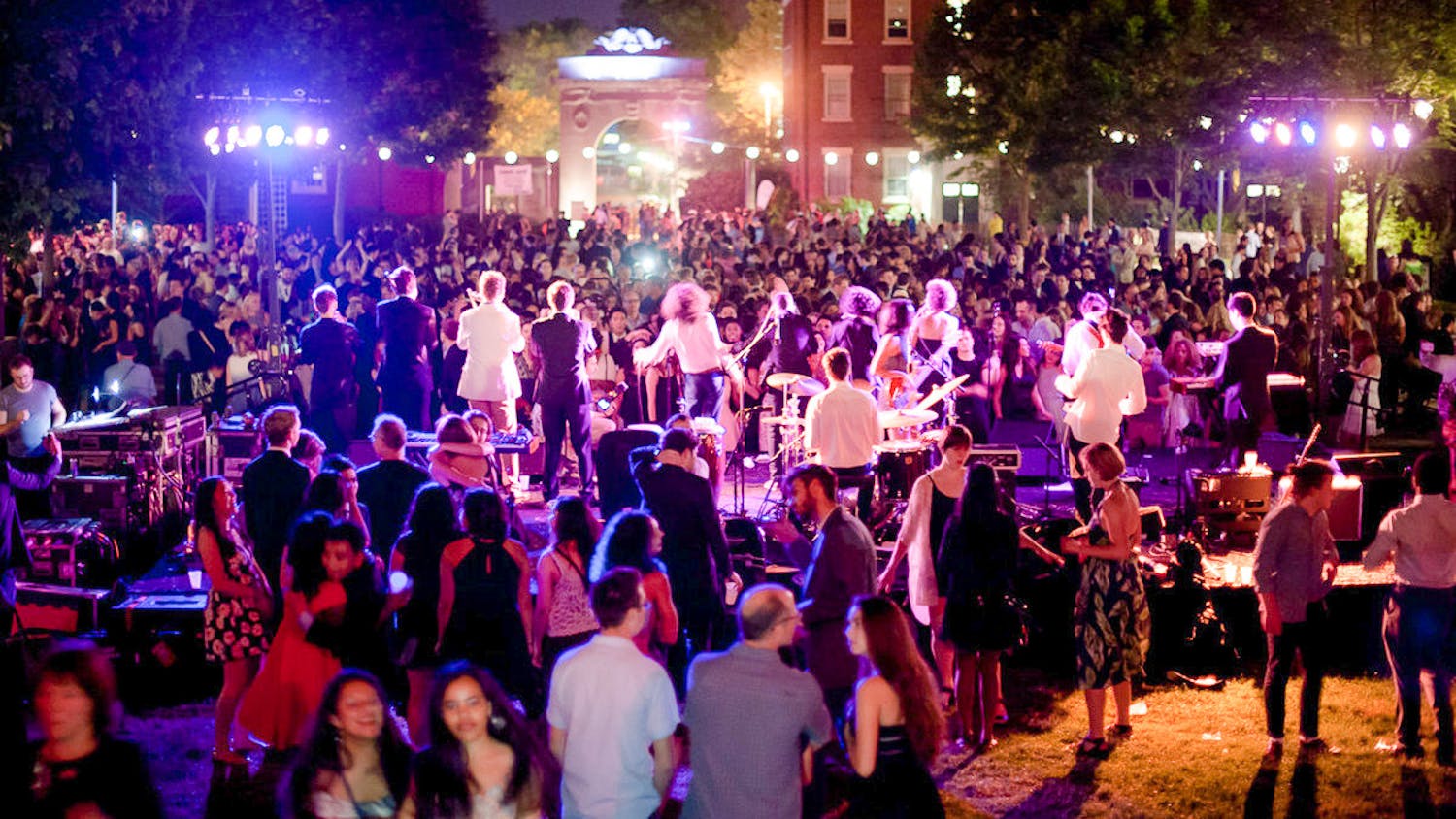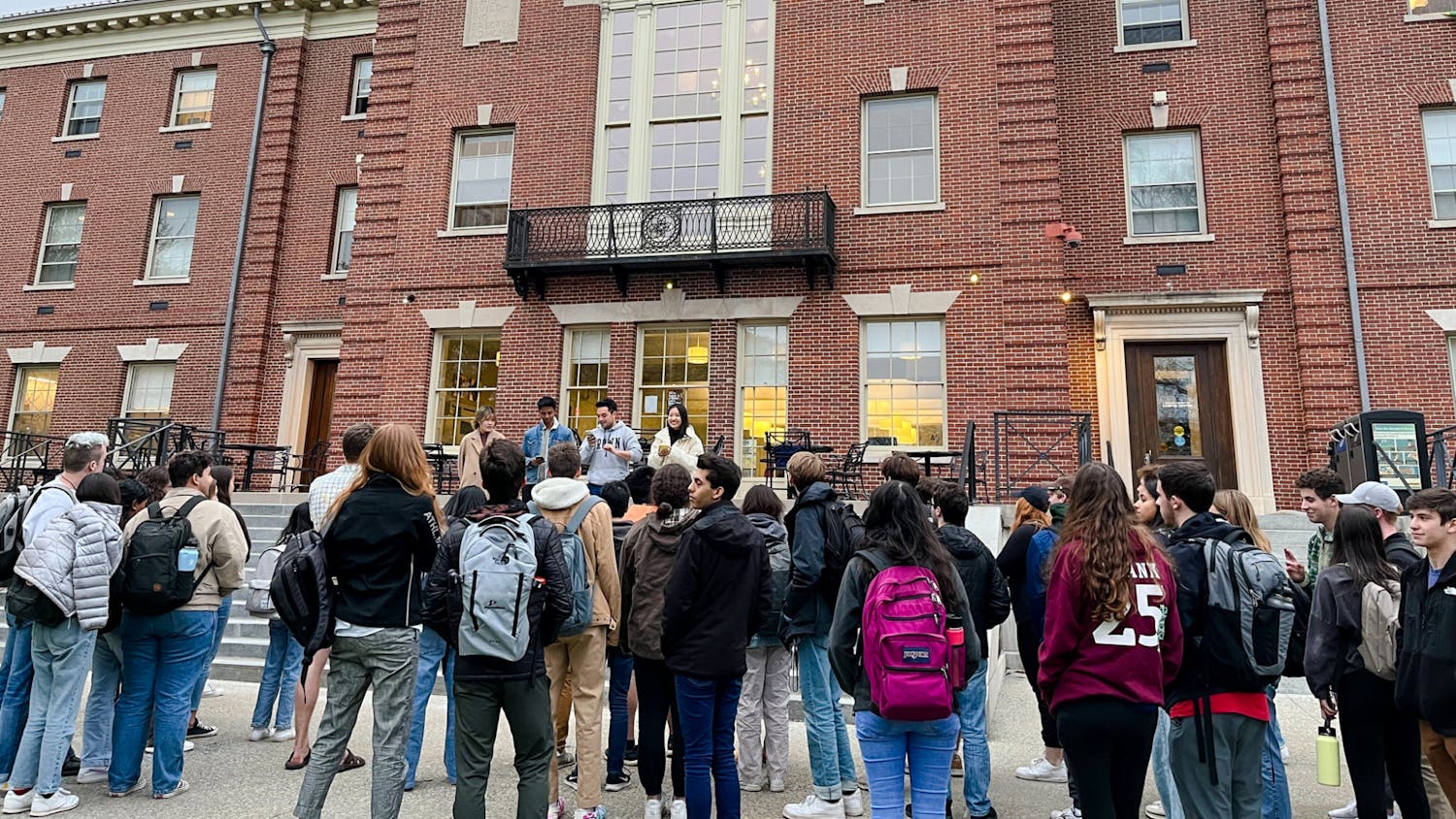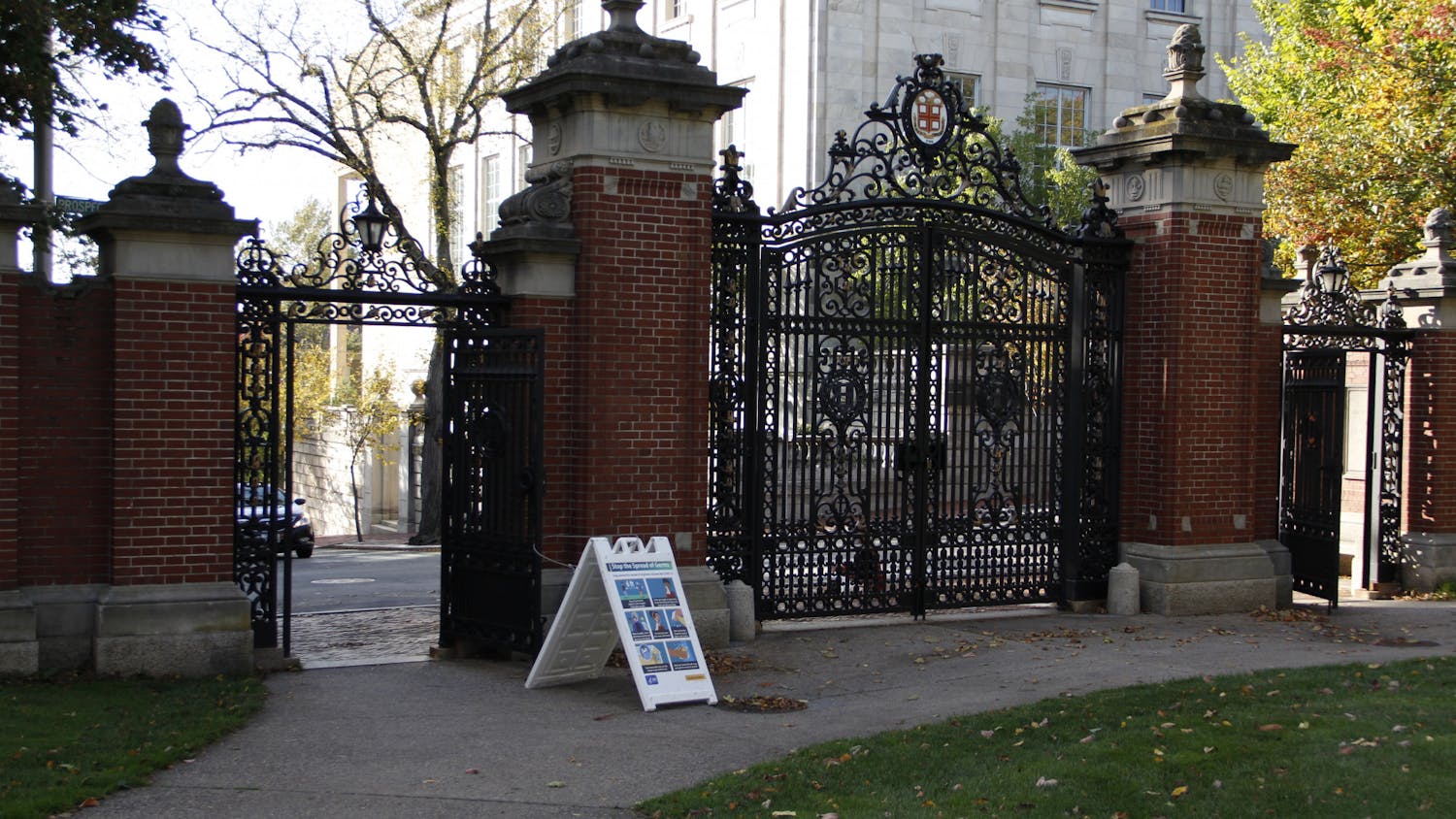If you walk around campus on any given Wednesday, you’re sure to spot a member of the University’s ROTC squad clad in army green. Despite being a relatively small population — only about 100 across both the undergraduate and graduate schools — the University’s military-affiliated students comprise one of the most enigmatic groups on campus.
While many students arrive at Brown straight from high school and exit the Van Wickle gates after Commencement to a civilian career, military-affiliated students follow a different path, committing a significant portion of their lives to public service.
Still, the University’s relationship with the military and its military-affiliated community members has been far from linear. At times, it has even been tense and tumultuous. As a result, the experiences of military-affiliated students are often unintelligible to their non-military peers.
An evolving relationship
Ties between the institutions have existed since the University’s founding and the Revolutionary War, the Office of Military-Affiliated Students notes on its website. Its ROTC programs, on the other hand, took root in the 1940s and ’50s, but were later subject to intense scrutiny in the late ’60s and early ’70s in the context of backlash against the Vietnam War, the Report of the Committee on the Reserve Officer Training Corps explains.
In 1969, University faculty members voted on a series of resolutions that would remove the status of ROTC as a credit-earning academic department, recommending that it exist as “a special scholarship program sponsored by the Department of Defense,” The Herald previously reported. Later, in 1972, all ROTC programs were moved off-campus.
But over the last decade, the ROTC and military presence on campus has gained new traction — particularly since the 2011 release of the Committee on the ROTC’s report on reevaluating the program’s ban from campus, The Herald previously reported.
“I feel like the dynamic has changed in the last few years,” said Amanda Guerriero ’23, an Army ROTC cadet. “When I joined as a (first-year), there were just very few of us in the program. I feel like when you wear the uniform on campus, people definitely look confused. … But in the last few years as the program has grown, the campus awareness is a lot greater and there’s maybe a little less animosity. But there’s definitely still some friction points.”
“My first year, we had about 10 or 11 (Brown) cadets in the program,” said Tyler Jones, a U.S. Army Lieutenant Colonel and the head of the Military Science department at Providence College. “Now, we have 19.” Providence College hosts Rhode Island’s Army ROTC program, accepting cadets from a number of institutions including Brown.
This year’s graduating class will include only one ROTC member — an army cadet that will enter active duty post-graduation — but next year’s class will include four Army ROTC cadets alone, Jones added.
Military connections on campus
While Jones has only directed the Providence College ROTC for three years, he noted that during his tenure he has seen relations between the University and the program improve.
The University “has been consistently supportive,” said Jones. “That consistent support has allowed us to grow.”
Jones added that, in particular, the program has found an ally in the Office of Military-Affiliated Students, which aims to support both ROTC cadets and any University community members that have military connections.
“The Office of Military-Affiliated Students aims to support the military-affiliated community in many different ways, but often it’s being an advocate for this population on campus,” wrote Mac Manning, the OMAS program director, in an email to The Herald. “This can include connecting said students to the various resources that Brown has to offer, speaking to prospective students, offering specific programming aimed to improve the overall experience here at Brown and working with different offices such as admissions, Financial Aid and the registrar.”
The community, Manning explained, doesn’t only include students enrolled in various ROTC programs but also student veterans, who can apply to the University via a specific veteran application. Currently, there are about 30 undergraduate veterans, but, including graduate students and dependents, the number exceeds 100, he added.
“OMAS students, particularly veterans, have unique personal experiences that they bring to the table. It’s important to understand that there are many different reasons why someone may join the military,” Manning said. “It’s also important to note not that all military experiences are equal. … As a result, OMAS students offer rich and diverse experiences to the Brown community.”
The transition from service to academia and, conversely, out of academia into a life of service, is distinct from the typical pathway from college campuses to civilian life.
“What you see (at Brown) is a lot of students coming straight out of high school, usually elite high schools,” said Nikhel Sylvain ’22.5. Before enrolling at the University, Sylvain served for six years in the Air Force Reserve with three years of active duty. During that time, he also enrolled in community college. A year and a half ago, he applied to Brown as a traditional transfer student.
“Having a six-year gap, that was pretty difficult,” he said. “I remember my first semester, I felt like I had to work five times as hard as everyone else to obtain the same kind of grades.”
Being a military-affiliated student on campus can, indeed, add its own unique challenges to an already-daunting college experience.
“There’s definitely a lot of fun times (in ROTC) — and the camaraderie just makes everything a lot more fun — but also as a female, it is a little challenging to find your place,” Guerriero said. “In freshman year, I struggled with … how to fit in in an (ROTC) class that was almost all men and to feel like you’re equally valued as your peers.”
As their time in the program went on, though, Guerrerio noted that they were able to find their stride.
Sylvain, too, explained that his background as both a veteran and middle-class student changed the way he viewed and interacted with the general “Brown bubble.”
“Coming to Brown, I saw different opportunities exist,” he continued. “I was like, ‘Oh my gosh, 10 years after Brown, the average salary is $120,000. That’s so incredible!’ And then sitting at a table full of traditional Brown students, they looked to me and said, ‘I hope I’m making $120,000 in my first year.’ I was really confused.”
Preparing for service
When students enter the Army ROTC program, they spend their two years as underclassmen taking a series of foundational military science courses and engaging in mission simulation exercises that inform the work they do over the course of their training, Jones explained. By their junior year, cadets are finally given more significant leadership roles and begin preparations for moving out of the college environment and into a world of duty.
“It’s melded pretty well with my college experience in general,” Guerriero said. “A lot of the best friends I have are from the ROTC program at Brown.”
In the summer between junior and senior year, cadets travel to Fort Knox to be assessed against other students from programs across the country. “The junior year is kind of the culminating experience of being a cadet,” he added. Finally, cadets return in senior year to run the Army ROTC program. It is also in this final year that the transition from college to service truly begins.
“It’s a very deliberate process,” Jones explained. “It starts with getting their branch, which they get in December of their senior year.” Cadets are able to rank their preferences for which of the 17 branches of the army they would like to enter post-graduation and are matched based on both the spots available for new recruits and their evaluations at camp in Fort Knox and in their program in general, he continued.
“Once they have their branch assignment, then their first assignment in the army will essentially be basic training for that branch,” Jones said. “So, say an officer has matched into the armor branch, they’re going to learn how to function as a tank commander (and) lead tanks in battle. So they would go to Fort Benning, Georgia, where they learn (those skills).”
While many ROTC members aspire to become full-time members of a branch after graduation, options other than active duty are open to students as well. “There are, in any given year, about 5500 Army ROTC cadets across the country and usually only around 3000 that get to go into active duty,” Jones said. “If a cadet wants to be in the reserves or the National Guard, they can choose (that).”
Beyond the Van Wickle Gates
While ROTC doesn’t train its students for specific duty tasks, it does instill in them a broad knowledge base with an emphasis on leadership, which its program heads believe will allow graduates to be successful in any military role and, more generally, in life, Jones said.
“My plan right now is to commission as an active duty officer,” Guerrerio said. “I have a four-year service commitment, and I’m thinking a lot about my top branch choices right now. … But after that, I think it just depends on my experience and if I feel like it’s a good place for me to be.”
No matter what she chooses to do once her service commitment is complete, Guerrerio feels that the leadership training she received in ROTC would prove useful for the rest of her life.
“I’m not a natural outspoken, take-charge kind of person. But definitely I feel like, with my training the last few years, whenever I’m in a position where I need to take a leadership role, I’m so much more comfortable and confident than I would have been as a (first-year),” she continued.
Nonetheless, transitioning from the college campus bubble to military life can be daunting.
“If you choose active duty, you enter the army feeling like you know nothing, but you have all these people around you that have been around doing this for a very long time, but you’re in charge,” Jones said. “It’s humbling and it’s stressful in its own way. … I don’t know that this happens in the civilian world quite the same way. You don’t enter an organization in the civilian world and then be made the boss of people that have been around for 20 years.”
Regardless of the challenges, members of ROTC and OMAS expressed their belief that connections with the military often yield new and valuable lenses through which to view the world — both at and after Brown.
“Coming to Brown with the little bit of life experience that the military allowed me was really interesting,” Sylvain said. “Sitting in (international relations) classes … I think it’s pretty eye-opening to have kind of lived the textbooks to some extent.”
While Sylvain plans to work in finance after leaving the University, he still feels his military experience will color the trajectory of his career in one way or another.
“Serving in the nation’s army or in the military in general, it provides you with a different lens of how to assess and how to solve problems,” Jones said. “I do think that service in the military is about leadership, and that leadership is directly relevant to any given job or profession after service. … Understanding people, relating to people, being able to lead and bring people together as a team, getting them to achieve a common goal — it’s all of those things.”





